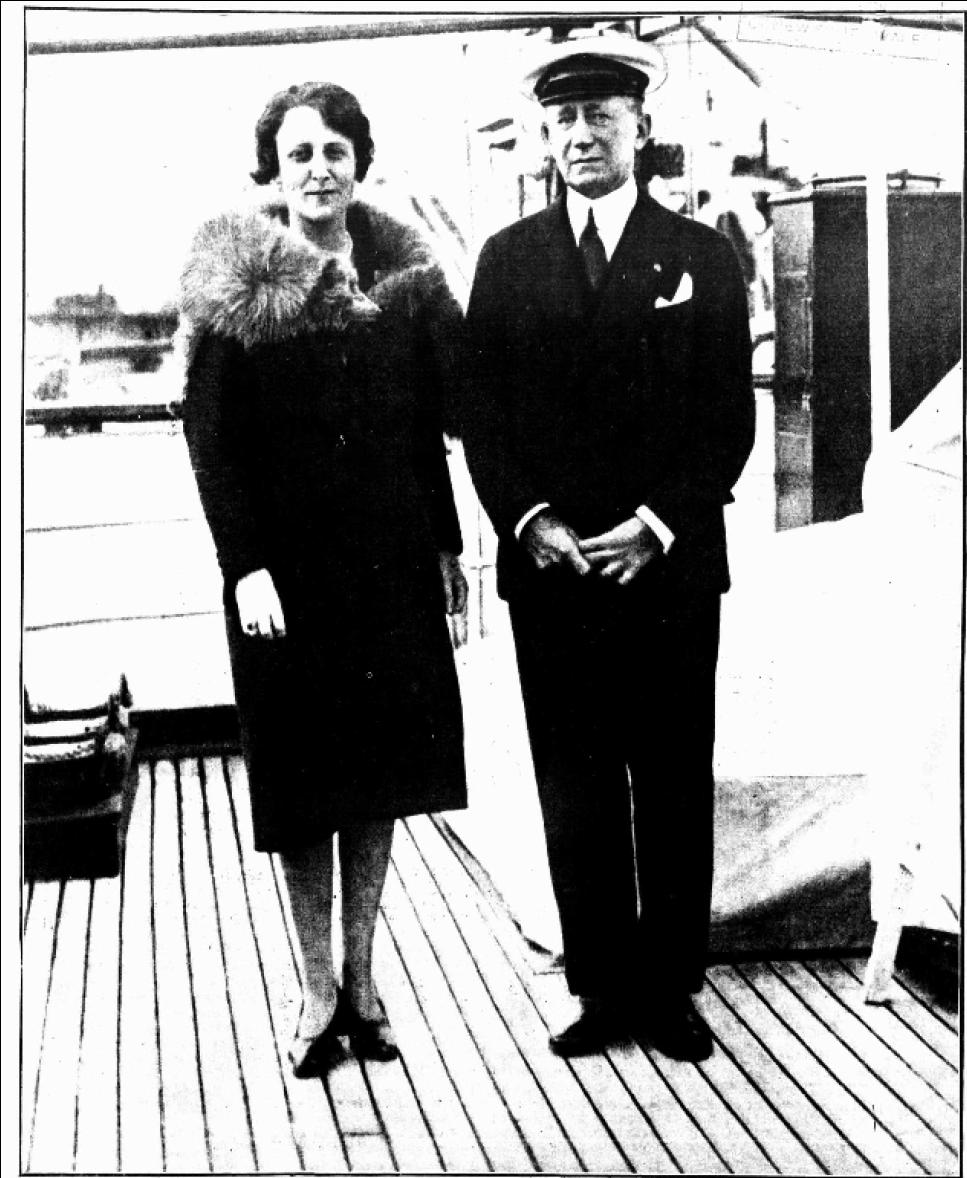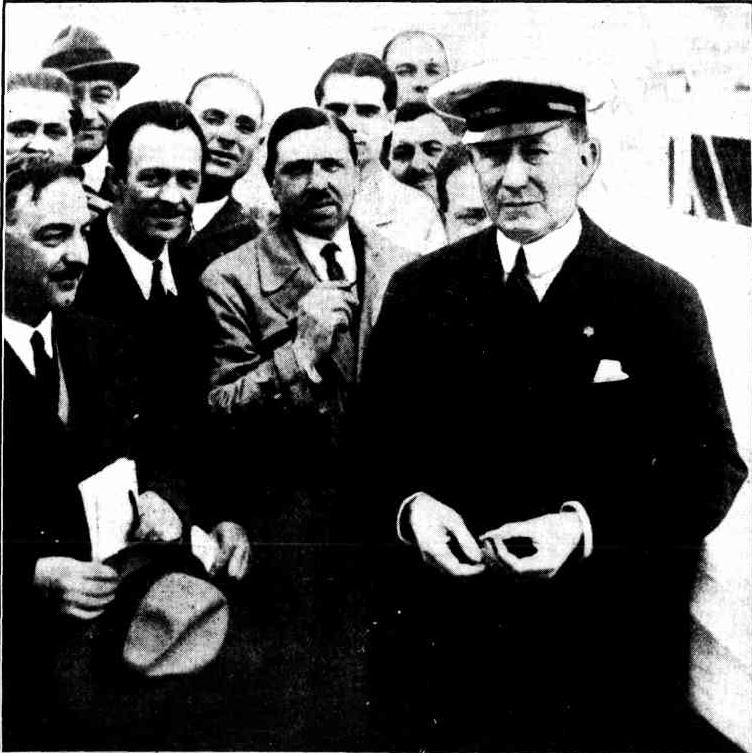Celebrating World Radio Day: The Bilgola Connection With The Beginnings Of Radio In Australia
13 February 2017
Despite the rise of television, the internet and online streaming, radio continues to be one of the main ways we consume media. Radio offers a platform for a wide variety of voices, is a critical way we communicate in times of emergency, and continues to be a daily source of news, entertainment and current affairs for Australians.
Throughout its history, radio has been able to successfully adapt to meet the changing needs of listeners and to find new audiences.
To celebrate World Radio Day, we’re taking a quick look at the history of radio in Australia:
1922 – the first Australian radio broadcasting license is issued
1932 – the Australian Broadcasting Commission is established
1939 – Prime Minister Robert Menzies announces that Australia will be entering the Second World War on every radio station in Australia
1954 – the transistor radio is invented, making radios portable and common in cars
1972 – Australia’s first community radio station 5UV is founded
1972 – the first Indigenous produced radio program premieres on 5UV – there are now over 130 Indigenous radio stations across Australia
1974 – the first FM radio license in Australia is issued to 2MBS Sydney
1975 – 2EA Sydney and 3EA Melbourne begin broadcasting in different languages. In 1977 these stations are expanded to become the Special Broadcasting Service (SBS) – today SBS broadcasts in over 60 languages
1980 – the Central Australian Aboriginal Media Association (CAAMA) is created – today CAAMA has over 600,000 listeners across Australia
2012 to now – the ABC and commercial radio providers introduce streaming apps to listen to radio on your mobile phone. Podcasts bring radio content to a whole new generation.
World Radio Day is an observance day held annually on 13 February.
World Radio Day is about celebrating radio, why we love it and why we need it today more than ever. A day to remember the unique power of radio to touch lives and bring people together across every corner of the globe. It was proclaimed on 3 November 2011 by UNESCO's 36th General Conference after originally proposed by the Kingdom of Spain.
In 2014 a theme was introduced of 'Gender Equality and Women’s Empowerment in Radio'. In 2015 the theme was 'Youth and Radio' with the goal of increasing the participation of young people in radio. The sub-themes of the Day were:
- Celebrating Radio - showcasing the power of radio as a medium.
- By youth, for youth - highlighting the contribution of young people as creators of radio content and improving their participation.
- Safety & Security - building awareness of the risks faced by young international freelancers and fixers, especially in humanitarian and disaster zones.
The theme for World radio day 2016 was 'Radio in times of emergency and disaster'. The sub-themes of the Day were:
1. Freedom of expression and journalists’ safety should be disaster-proof.
2. Radio empowers survivors and vulnerable people, whose right to privacy is to be respected.
3. Radio has social impact and provides access to information. People’s right to information should be protected.
4. Radio saves lives.
5. The immediate accessibility of radio frequencies is essential to saving lives. These frequencies should be protected in times of emergency.
The theme for Radio Day 2017 is 'Radio is You', with the goal of celebrating how audiences interact with Radio. The theme was designed to encourage radio stations to be the best they can, by having audience engagement policies, ethical committees, public editors, self review programmes and by ensuring their community radio networks were strong. A record number of countries, took part in World Radio Day 2017 with more than 500 events worldwide.
The theme "Radio is You” was chosen because radio is everything it is because of its listeners. The theme puts the spotlight on audiences, ensuring their views and diversity are represented on the airwaves. The theme is a chance to look at all of the different ways that radio engages audiences, not only on-air but through “listening to listeners” in the planning and policy of radio.
Our area has long had a few connections with early radio in Australia - items which have run in previous History pages, and a few extras, from those times are:
RADIO DANCE
WIRELESS MUSIC Magna Vox at Moore Park SYDNEY, Thursday.
The members of the New South Wales Military Radio Association are holding their annual dance next month. They are so enthusiastic that they will not get away from wireless for even one night. The dance will be held in the engineers' depot at Moore Park, and the music will come from Strathfield. For the first time in Australia, so the organisers say, a complete Magnavox will be used. It has just arrived from New Zealand. At the residence of Mr. C. Maclurcan, in Strathfield, there is a Pathephone. Mr. Maclurcan is also the owner of an up-to-date wireless station. Music played by the Pathephone — some of it has not been heard in Australia — will be radiated into the air by Mr. Maclurcan's wireless set. The radio men will instal a wireless plant at the engineers' depot, and the music will be received at the depot and amplified by the Magnavox. It will then be hurled into the dance room, and gentlemen will be asked to select their partners. It is likely, too, that there will be a couple of songs. Music for the Magnavox can be heard 3000 yards from where the machine is situated. RADIO DANCE (1922, June 1). The Newcastle Sun (NSW : 1918 - 1954), p. 6. Retrieved fromhttp://nla.gov.au/nla.news-article163680550
This 'Mr C. Maclurcan' is Charles Macluran, the son of Hannah Maclurcan, the lady who once owned Bilgola House, and was a self-made business woman who later owned and ran the Wentworth Hotel in town.
Jane Arakawa, a lady who put together an article on Charles Maclurcan in 'Who was radio pioneer Charles Maclurcan?' published online in 2015, states "I learnt that Charles Maclurcan erected aerial masts on top of the first Wentworth Hotel located on Church Hill, Lang Street Sydney in 1911 and was communicating with incoming and outgoing ships. By early 1922 he was broadcasting an entertaining and engaging radio program each week with a program guide published in the weekly newspapers of the time. He was issued Licence No.1 in December 1922 and continued his broadcasts and experiments until 1927 when he was required to take over the management of the Wentworth Hotel until its sale in 1950."
Retrieved from
Bilgola House courtesy State library of NSW - picture dated 1935.
WITH WIRELESS AMATEURS — Boys Who Are Learning Radio Craft
MR. MACLURCAN'S ENERGIES AT STRATHFIELD
Australia is not quite a back number in the field of wireless experiment. There are many hundreds of amateurs who are achieving excellent results — usually with apparatus manufactured by themselves—despite the official restrictions placed upon them. With their own receiving plants they frequently receive messages from as far away as America
and Europe. Probably the most successful of these experimenters is Mr. C. Maclurcan, of Strathfield, who recently achieved a record in long-distance sending with the minimum of power when he transmitted a message 400 miles with electric power equal to that used in a pocket torch. It is hoped that in the near future the authorities will grant licenses to transmit to genuine experimenters. The original objection to this was that, the messages from many private stations would interfere with official and shipping messages, but that objection is now a »*hing of the past; The' old spark transmitting set has been replaced by the valve instrument, the timing of which obviates the chance of messages clashing. The ranks of the local wireless experimenters include a number of boys who display remarkable genius and ingenuity in building their own equipment. One juvenile enthusiast receives wireless messages through the medium of an iron roof in place of the orthodox aerial of poles and wires. Another listens to radio messages transmitted thousands of miles away through an equipment of his own manufacture, in the construction of which two wooden match boxes were pressed into service. Jack Davis, a Grammar School boy of 14, made the complete one-valve receiving set shown in the accompanying picture, and with it frequently entertains the family visitors with music being sent out from the Melbourne radio station, or by Mr, Maclurcan at Strathfield. Another young Marconi is Bob Webster, aged 10, of Ariah Park, who in nine months learned wireless operating.
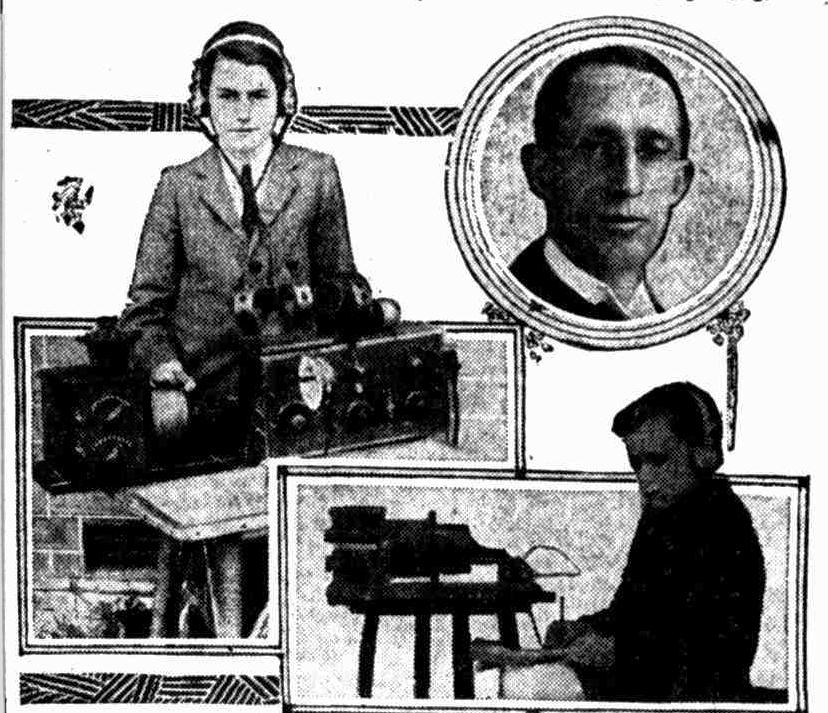
In the circle is Mr. C. Maclurcan, -who experiments at Strathfield. The boy at the top is Jack Davis, with his home-made receiver. The other boy is Bob 'Webster, of Ariah Park, The .lower picture to of Joseph D. ll. Freed, a 22 year-old -American in the Freed-Eiseman Radio Corporation, who is working on plans for a radio receiver to be made at the cost of a few dollars. WITH WIRELESS AMATEURS (
1922, July 9).
Sunday Times (Sydney, NSW : 1895 - 1930), p. 1 (Sunday Times Social and Magazine Section). Retrieved from
http://nla.gov.au/nla.news-article128220139
Wireless for Amateurs
How to Make a Simple Receiving Set
By a Licensed Amateur
The wireless amateur begins to learn the mysteries at the bottom. With a crystal receiver set, described in this article, which he can mafye himself if he has an aptitude for mechanical, he can hear Morse from vessels at sea and from land stations. With a perfected one he can hear telephone speech and music several miles off. An amateur at Coogee has "received" from Mr. Charles Maclurcan's station at Strathfield. Afterwards he may progress to the higher levels and hear concerts by wireless over hundreds of miles.
The article has been written as a guide to the boy or man who, attracted by wireless and yet knowing nothing or next to nothing, of the science wishes to take it up as a hobby. The theory of wireless has been described in the simplest manner, and the actual handling of the instruments has also been explained in a straightforward way. The expert may claim that some of the examples quoted are not strictly correct. This is quite true; but the writer has considered it better to depart slightly from the strict truth in certain cases in order to make the article a clear and popular one. The exceptional amount of interest which is centred on wireless telegraphy in other parts of the world seems bound in have its reflex in Australia. The not-able success achieved by a Sydney experimenter, Mr. C. Maclurcan, of Strathfield, who, using power only strong enough to light the tail lamp of a car, has transmitted speech and music by wireless over a distance of 700 miles, has attracted the attention of many people who until a few weeks ago had not displayed any active interest in wireless. It seems to be only a matter of lime before the radio "boom" or "craze" which has infected the people of other countries will make itself felt here. Already in Australia large numbers of enthusiasts maintain their own sets and derive a good deal of plea sure from 'listening-in' to the various land and ship stations. There is, of course, a vast difference between the simple receiving unit of the amateur and the latest commercial installation in a ship or shore station; but it must be remembered that the know ledge required to construct and maintain the latter was first acquired by experiments with simpler instruments.
WIRELESS telegraphy to be the roughly understood needs a lifelong study. Why, then, it may be asked, do so many people who know so little about it, and who have not the time to find out, take such an interest in it in places other than Australia? The answer is a simple one. Al though the science of wireless itself is so deep and so complicated, the actual hand ling of the instruments has been made so simple that even a child can use them. In many cases all that is needed is a slight turn of a knob or handle, and the listener will hear messages speeding through space. Expert manufacturers have devised and made receiving sets which combine the latest developments with sheer simplicity, and by purchasing one of these sets and following out the printed instructions one may hear all that is to be heard. They range from small instruments capable of receiving only about 15 or 20 miles to units which will receive long distance mes sages on long waves, and vary in price accordingly. Already in Australia manufacturers are at work, and small receiving units may be purchased for as low as £1.
Make Your Own
THERE is, however, one particular class of wireless 'fan' for whom this sort of receiver holds no charms. It may be satisfactory to the person who wishes to hear sounds and end his wireless know ledge at that point; but to the genuine experimenter the home-made or home-assembled set holds most attraction. The shop made unit may look well as a piece of furniture, but the genuine student in all cases is prouder of a few shillings' worth of gear set out, on a small table, amidst a maze of wires understandable only to himself, than the owner of the most expensive ready-made outfit. The person who, having no knowledge of wireless, is desirous of commencing his studies in most cases finds himself faced with grave difficulties. Very often he is a boy or youth whose funds are limited, and consequently anything he wants must be made by his own hands. On commencing to study, he finds that, although a multitude of first-class text-books are available to him, and clear and capital descriptions are given of the various plants, he is almost invariably at a loss to discover where to start. In many cases he is tempted to commence on a large scale, and so ends in failure. The novice will be well advised to commence his work, with the construction of a simple crystal receiving set, and he will find quite sufficient in it to occupy his attention until such time as he has made further advancement in the science and is prepared to take over the construction or assembling of a more complicated type of receiver. If you decide to take up wireless as a hobby and to either construct or assemble your own set you will find from the outset that you have turned your attention to something which will take up more than a mere few days of your time. You will find that the actual making or wiring of your instruments constitutes only a small portion of your task, and that, before you can either make or use receiving set you must mas ter the rules and laws governing its operation, and intelligently understand each small part of the unit. An elementary knowledge of electricity and magnetism is desirable, if not essential. Many cheap textbooks on magnetism and electricity can be purchased and the novice would be well advised lo study one of them before turning to wire less. If he does so he will, find that his knowledge of wireless will come very much easier. It is only within comparatively recent years that the discovery was made that a disruptive electrical discharge causes electro-magnetic oscillations, or waves in the ether.
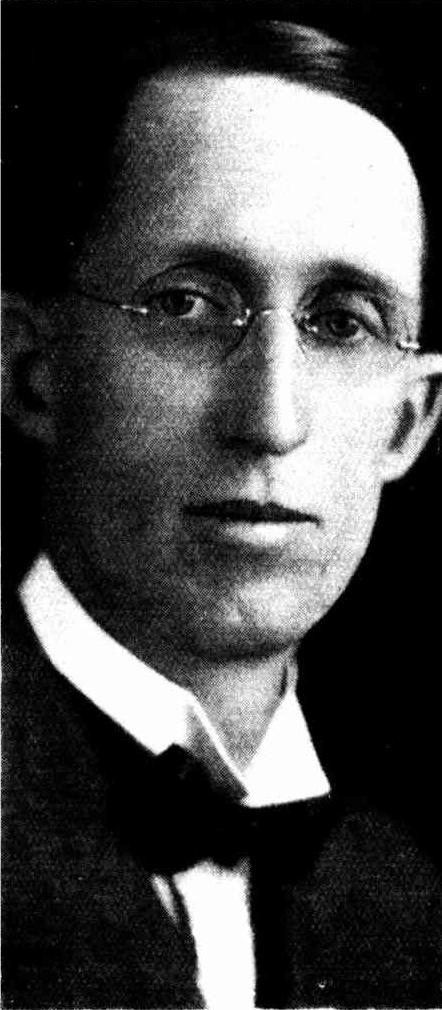
The amateur wireless experimenter. Charles Maclurcan, of Strathfield, who, with low-power transmission, is putting up records in wireless.
Heinrich Hertz, a German scientist, in 1888 devised a means of proving that these waves existed; but he apparently did not fully grasp the importance of his discovery, and, it was left to others who followed him to utilise the waves, which are often named Hertzian waves, for wireless telegraphic purposes. You have noticed that if a stone is dropped into a pond of still water waves radiate in circles from it , spreading and spreading until they either reach the banks or die out. The water itself does not travel, but a wave is caused and moves rapidly away from the centre of the disturbance. If we place a fishing float or a cork in the pond, and drop the stone into the water some little distance away, we have an illustration which, although not altogether quite correct, is a capital example of what takes place concerning the transmission and reception of a wireless message. On the stone being dropped into the water waves radiate in all directions, and on some of these reaching the float they cause it to move up and down. Similarly an electrical disturbance is created in the air at a wireless transmitting station, waves are radiated through the ether and affect the in instruments at any receiving station within their range.
It is our object to describe merely a wireless receiving station. At the sending station apparatus is used by means of which messages in the form; of dots and dashes are transmitted on various-sized waves. It is the function of the receiving station to interrupt these waves, to lake them out of the. ether, and to make them audible to the human ear.
This is the transmitting and receiving wireless "set" of Mr. Charles Maclurcan, of Strathfield, who sends out concerts every Sunday night for all who care to listen — if they have the necessary apparatus. He uses 8.75 watts of power, which is less than what is required to light the ordinary electric bulb, and has been heard at Auckland. The receiving apparatus is on the left, the transmitting on the right. The listening phones lie on the front of the bench with the half-hoop connecting them. The microphone transmitter, through which speech and music are broadcasted, is the instrument with the bellmouth near it. The receiving set has three valves (they look like three crosses in the picture). Below it to the left is the radio frequency amplifier; above it the wave-meter. The box on top, below the two dials (the left of which shows the output of the aerial) is a portable receiving set.
The Aerial
IT is necessary therefore firstly to have some instrument or device to catch the waves — or, rather, portion of the waves — and this is the function of the aerial. Briefly, the aerial consists of a carefully insulated wire or series of wires suspended in the air and connected to the receiving instruments. There are several forms of aerials in use, but the most common sort are those known as the 'T' (as shown -in figure' '1) and inverted 'L' type (figure 2). Amateurs will he well advised lo use either of these two classes, but should space be limited the 'umbrella.' type of aerial can be used. With, a crystal type of receiver height is desirable, and, although smaller distances will, no doubt achieve results, the wires, if suspended about 40 feet in the air, result in the station working satisfactorily. Length is also desirable, but. in many cases it, is not possible to secure a big span between the supports. An aerial as short as to feel, will, under certain circumstances, give results: but the average suburban resident should not experience much difficulty in placing his posts about 100 feet apart — a distance which should prove quite suitable. A variety of wires may be used, including stranded copper, bare copper, phosphor bronze, and others. Bare copper wire, about 14 gauge, acts admirably, and may be purchased at a reasonable price at any electrical store. Careful insulation is the next point to be considered, and any neglect or lack of care in this direction will spell failure. The function of the aerial, is to collect the ether waves and convey them to the instruments. Any fault in the insulation, therefore, will mean that a leakage will occur and that nothing will reach the detector and timer. The two wires of the aerial should be kept apart by 'spreaders'' made of wood and about 6ft long. The wires should not be attached to the spreader itself, but should end in an insulator, which in turn should be connected to another insulator and then to the spreader. There is really no need lo describe the method of hoisting the aerial beyond staling that a pulley attached' to the top of the mast' with a rope reeved through' will be sufficient. It is a good plan, however, to attach the rope used for the actual hoist to the ropes which bold the spreader by means; of an insulator, thus ensuring the maximum amount of insulation.The leads, from the two wires should be soldered so as; to make a perfect connection, and led to the side of the house. In theory the leads should be kept separate until they reach the instruments, but if they are joined outside of the house, either by solder or by a' special screw clamp, and a single wire is run inside, satisfaction should be obtained. In leading in the wire from the aerial to the house the greatest care regarding insulation should be observed. It is a good plan to use heavily insulated wire, and to run this through a glass tube which is fitted from the inside to the outside of the room, either through a small hole in the wall or through an ordinary ventilator. If these instructions are carefully carried out an; aerial which will give the best of results should be erected. Should the enthusiast-be neglectful of any of these seemingly unimportant details, he cannot reasonably hope to receive successfully. The main point to remember is that the aerial is the ear, or 'feeler,' of the set, and that if it is not constructed in a manner which will enable it to feel or listen for the waves and then convey them to the receiving unit, the latter series of instruments will be quite useless. Having thus erected an aerial, the beginner has now the means of taking from the air any messages which may be in transit, and he must next run his attention to the instruments by means of which he can make these messages audible.
The Detector
in the receiving unit in a crystal set of the simplest type, and which is almost invariably used by the beginner, consists of a crystal detector, a tuning coil, and a set of telephone headgear. The last named portion of the set is quite beyond the scope of the novice as far as manufacture is concerned, and consequently will have to be purchased.
Mr. Maclurcan's home and aerial at Strathfield, Sydney.
Makes and qualities vary, of course, in price; but a telephone quite suitable should be available at a cost of about £2 or £2 10s. In an article which is intended to simply, and in a nontechnical manner, describe wireless, the action of the telephone cannot be detailed. This must be left to the amateur to investigate, as he progresses with his studies: but, put briefly, the function of the telephone is to transform the electric currents into sounds. This is done by means of an electro-magnet and a diaphragm which are contained in the 'phones, the various currents acting! in' such as a manner as to displace the diaphragm, which : acts as the head of a drum and causes the sound. The detector; as the name implies, is that portion of the receiving unit which detects , the oscillating waves 'caught' by the aerial and thus leads to the set. When we say that the detector 'detects' the oscillations, w:e really mean that it transforms them into definite signs which the telephones make audible. As previously pointed out, when a message is transmitted the oscillating current produces the wave, which is caught by the receiving aerial and is led to the receiver in the form of an osculating current. Most; amateurs know that an oscillating current is one which moves rapidly backwards and forwards, changing the direction of its flow many times in even the fraction -of a second. If this current were passed through ; the receiving set no audible result , would ensue but if means are devised to make a steady or direct current of it, then it can be transformed into audible sounds. The crystal detector is the instrument which does this work. It has been found that many types of crystals are peculiar, inasmuch as they will allow a current: lo pass through them in. one direction only. Actually a small amount of an oscillating; current does return if passed through a crystal; but; as far as the crystal receiving set is concerned none of the current returns. It naturally follows, then that if we insert a crystal, in our circuit, or in oilier words if we pass the waves we catch in our aerial through a crystal, we shall transform the current from an oscillating current into a direct current, and so make it readable in our 'phones.
Magnavox, model A1R, Sn. 760, 1922
With names like Amplivox and Telemegafone, the Magnavox Co. of Oakland, California was one of the first to break through the sound barrier of volume with units that reproduced voice and music with acceptable listening quality. The 1920 catalog testifies, “According to Government reports, the volume attained is too great to be measured or even estimated…It carries up to seven miles yet with all this power, purity of tone is never lost.” The catalog makes a point of this portability showing images of picnics, outdoor public gatherings and ballrooms full of dancers, advising that it can be powered by any car battery. Information from a 1919 news release stressed that this was a complete system consisting of a large 18-inch horn speaker, a control box, a six-tube amplifier, and a model ST-4 four-button carbon microphone. This system, plus an additional horn, was used to broadcast President Woodrow Wilson's speech to 50,000 people assembled in the San Diego Stadium in 1919.
On the other side of the country, Western Electric was also deep into the race, producing the first amplified loud speaking unit in 1913, although the tonal quality left much to be desired. These very first loud speaking units were battery powered electromagnets that pulled and pushed metal diaphragms in the same pattern as was transmitted to them from a corresponding microphone unit. These thin metal diaphragms mounted at the bottom of a horn, basically a megaphone, reproduced the vibrations they received and pushed the corresponding air waves through the horn to be heard. The addition of tubes increased the voltage that could be used to drive the electromagnets.
NEAR AND FAR." At Narrabeen last Saturday, at a concert In the grounds of Mr. Charles Schultz's, week-end home, 500 people were afforded an opportunity of hearing music "culled from the air." It had been transmitted from Mr. Basil Booths wireless station at Clifton Gardens, and received on Mr. Leonard Schutlz's four-valve receiving apparatus. The concert had been arranged by the Narrabeen Surf and Life Saving Club to augment its funds, and as a result of the efforts about … was added to their funds. The Black Cat Concert Company contributed the second half of the programme, the artists being Norman Hence, E. Cope, P Walsh, L. Bancroft, M. Bancroft, G. Hynard, J. and A. Roebuck. NEAR AND FAR. (1923, April 3). The Sydney Morning Herald(NSW : 1842 - 1954), p. 4. Retrieved from http://nla.gov.au/nla.news-article16053743
Indicating the popular interest in the broadcasting of entertainments by wireless, the attendance at the radio concert at the Manly Literary Institute last night crowded the building. The concert was arranged by the Manly Radio Club, and musical items were transmitted to the hall from Mr. R. C. Marsden's experimental station at Edgecliff, and from Mr. Marks' station at Rose Bay. The audience was keenly appreciative of the entertainment, and the organisers of the concert were congratulated on its success.
An address on the broadcasting of entertainments was delivered by Mr. E. T. Fisk. He outlined the systems in vogue in America and Great Britain, and compared the proposed Australian scheme favourably with them. Mr. Fisk stated that in both America and England it had been found necessary to appoint special committees to investigate the schemes. In America, owing to the absence of restrictions in the past, an enormous number of privately owned plants had been installed, and this rendered reform difficult. In Great Britain there were restrictions, but the proposed scheme for Australia was expected to include more restrictions aiming to benefit the people as a whole. Broadcasting, Mr.Fisk said, was essentially competitive. The broadcasting companies, if they were to succeed, would have to provide the best entertainments possible. At the same time, the co-operation of the owners of receiving plants would be necessary, for unless the broad-casting companies were supported they could not continue. Broadcasting was peculiarly susceptible to the activities of the unscrupulous. It was a very simple task to erect an aerial at night and remove all traces of it after the owner had listened-in to a broadcasted concert without contributing to the costs. With complete co-operation between the owners of receiving sets and the broad-casting centres it would be possible to engage the very best talent at central radio rooms, and transmit concert, band, and other entertainments to all receiving plants, to gatherings in the municipal parks, to the crowds at seaside resorts, and to the far distant country centres. BROADCASTING. (1923, July 10). The Sydney Morning Herald(NSW : 1842 - 1954), p. 10. Retrieved from http://nla.gov.au/nla.news-article16079526
.jpg?timestamp=1384607487687)
Inspecting work, Sir Earnest Fisk on right, Chief of AWA, circa 1930's, image by Sam Hood, No: hood_02000, courtesy State Library of NSW
Sir Ernest Thomas Fisk (1886-1965) was a founder (1913) and later Managing Director (1916) and Chairman (1932) of Amalgamated Wireless (Australasia) (AWA). In 1944 was appointed Managing Director of the EMI music empire. He was knighted on 11 May 1937. Also see: Murray Goot, 'Fisk, Sir Ernest Thomas (1886–1965)', Australian Dictionary of Biography, National Centre of Biography, Australian National University, http://adb.anu.edu.au/biography/fisk-sir-ernest-thomas-6177/text10617
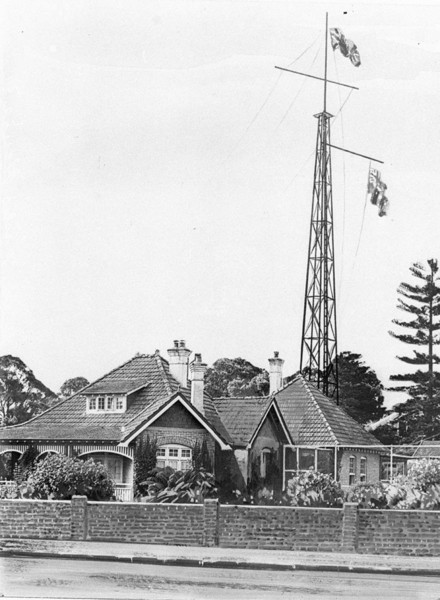 Right: Radio mast and Sir Ernest Fisk's home, Wahroonga (some sources state his home was at Roseville), Creator Hood, Sam, 1872-1953, Image No: hood_7681r, courtesy State Library of NSW. Date of Work after 1917 [probably Sept 1918] Home and Away - 7681 "At 3.15am GMT on the 22nd September 1918 the first direct wireless message was transmitted from the United Kingdom to Australia. The message sent for the Australian Prime Minister, Billy Hughes, whilst visiting his birthplace in Wales, was transmitted by Guglielmo Marconi from Carnarvon and received by Ernest Fisk at Wahroonga, 20 kilometres north of Sydney." (Wahroonga Amateur Historical Radio Association) [The Union Flag flies from the top of the mast and the Australian Flag, in the picture, from the arm? They are drawn in or highlighted]
Right: Radio mast and Sir Ernest Fisk's home, Wahroonga (some sources state his home was at Roseville), Creator Hood, Sam, 1872-1953, Image No: hood_7681r, courtesy State Library of NSW. Date of Work after 1917 [probably Sept 1918] Home and Away - 7681 "At 3.15am GMT on the 22nd September 1918 the first direct wireless message was transmitted from the United Kingdom to Australia. The message sent for the Australian Prime Minister, Billy Hughes, whilst visiting his birthplace in Wales, was transmitted by Guglielmo Marconi from Carnarvon and received by Ernest Fisk at Wahroonga, 20 kilometres north of Sydney." (Wahroonga Amateur Historical Radio Association) [The Union Flag flies from the top of the mast and the Australian Flag, in the picture, from the arm? They are drawn in or highlighted]
Guglielmo Marconi (25 April 1874 – 20 July 1937) was an Italian inventor, known for his pioneering work on long distance radio transmission and for his development of Marconi's law and a radio telegraph system. Marconi is often credited as the inventor of radio, and he shared the 1909 Nobel Prize in Physics with Karl Ferdinand Braun "in recognition of their contributions to the development of wireless telegraphy". As an entrepreneur, businessman, and founder of The Wireless Telegraph & Signal Company in Britain in 1897, Marconi succeeded in making a commercial success of radio by innovating and building on the work of previous experimenters and physicists. In 1924, he was ennobled as a Marchese.
Marconi operating apparatus similar to that used by him to transmit first wireless signal across Atlantic, 1901. T his image comes from the Google-hosted LIFE Photo Archive where it is available under the filename 4a204d82f07524bd This image (or other media file) is in the public domain because its copyright has expired and its author is anonymous. This applies to the European Union and those countries with a copyright term of 70 years after the work was made available to the public and the author never disclosed their identity.
Guglielmo Marconi. (2013, November 14). In Wikipedia, The Free Encyclopedia. Retrieved from http://en.wikipedia.org/w/index.php?title=Guglielmo_Marconi&oldid=581556368
Marconi Lights Sydney Town Hall From Yacht Off Italy
SWITCH OPERATED BY RADIO ACROSS 10,000 MILES OF LAND AND SEA
Darkened Hall At Wireless Show Filled With Blaze Of Light FIRST TEST TOO SOON. MARCONI REPEATS OPERATION
SYDNEY, Wednesday.— Wireless history was made tonight when the Marquis Marconi, from his yacht Electra, anchored in the Mediterranean, twice turned on the lights of the Sydney Town Hall. It was the greatest- experiment made in the transmission of wireless energy, and was the first attempt to transmit sufficient power to work a switch from a far station. The lights at the Town Hall flashed on a seventh of a second after Marconi touched a key 10,000 miles away. A huge crowd attended at the Town Hall where the Radio Exhibition is being held, and listened in darkness to short addresses. The director of the exhibition, Mr. M. H. Ellis, was interrupted in toe middle of a sentence by the lights being switched on unexpectedly, eight minutes before time. Mr. Ellis said it was probably a test. Applause thundered for a few minutes, and Mr. Ellis said there was a mistake in the time, although he had synchronised his watch with Marconi's 20 minutes earlier. Officials had the thousands of lights switched off again, and sent a Morse message to Marconi, asking him to repeat the illumination. Almost at. 8 p.m. Marconi replied, the hall suddenly blazing with lights. There was intense enthusiasm, and this time the lights remained on.
'This is a record performance for the world,' declared Mr. Ellis, -through, micro-phones. 'We have received another message from Marconi since he switched the lights on for the second time, saying, 'Very best congratulations to all concerned. Marconi.' Marconi realised a great dream tonight when he touched a key on the Electra's special transmitting set and sent signals to the Lon don end of the Anglo-Australian beam system. "By "
By the beam the impulse was sent to the Amalgamated Wireless receiving station at Rockbank. From, there it was relayed by land line to the head office at Melbourne, and thence to the head office at Sydney. From there the impulse was relayed to the Town Hall, where it released the power and closed the. circuit of the lighting system. To ensure the success of the teat extraordinary efforts were made, and officials at this end were in touch with Marconi until a few minutes before the switching on of the lights. The managing director of Amalgamated Wireless, Ltd., Mr. .E. T. Fisk, attended the exhibition with the' company's engineers. Only 12 years ago Marconi, in England, and Mr. Fisk, in Sydney, exchanged the first wireless message 'between Britain and Australia. ' Professor Kerr Grant (Professor of Physics at the Adelaide University) stated last, night that great as Marconi's success was, the things he had hoped for from the invention would apparently not be realised.
"The operation of a relay such as Marconi's experiment last night is of no particular scientific importance, except that it has never been sent before over such a range." No new principle was involved in it, said the Professor. It was the application of a method and apparatus well known to everybody in-terested in wireless. "The essential factor," he said, "was probably the. use of some highly sensitive form of relay. It may have been a recent German Invention known, in Germany, as the Glimm relay.'
Marconi Marconi Prof. Kerr Grant Prof. Kerr Grant Marconi Lights Sydney Town Hall From Yacht Off Italy (
1930, March 27).
The Register News-Pictorial(Adelaide, SA : 1929 - 1931), , p. 3. Retrieved from
http://nla.gov.au/nla.news-article53493887
Marconi and his Wife on the Electra
Marchese Marconi last week switched on from his yacht Elettra, then lying off Genoa, 2800 lights in the Sydney Town Hall by pressing a key which set in motion the ether signals that were transmitted by beam wireless to Australia. It was regarded as one of the most interesting experiments of the times in wireless transmission, and was a complete success. The photograph shows Marconi on the deck of the yacht with his wife, who was on the vessel when the signal was sent through. Marconi and his Wife on the Elettra (
1930, April 2).
Sydney Mail (NSW : 1912 - 1938), , p. 5. Retrieved from
http://nla.gov.au/nla.news-article160633042
WHEN MARCONI SWITCHED ON.
A photograph of Marconi surrounded by journalists outside the cabin on his yacht just after he had switched on the lights at Sydney Town Hall during the recent exhibition in connection with the electrical and wireless trades. There was great excitement in the harbour at Genoa, sirens sounding, bells ringing, and even an artillery salute being fired from the battery. WHEN MARCONI SWITCHED ON. (
1930, May 14).
Sydney Mail (NSW : 1912 - 1938), , p. 13. Retrieved from
http://nla.gov.au/nla.news-article160631182 
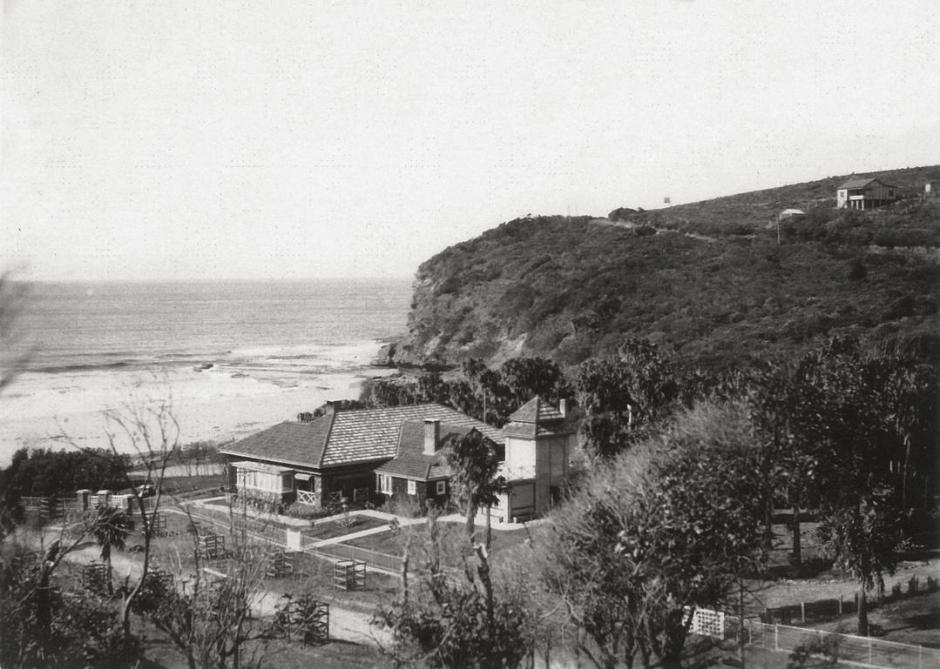


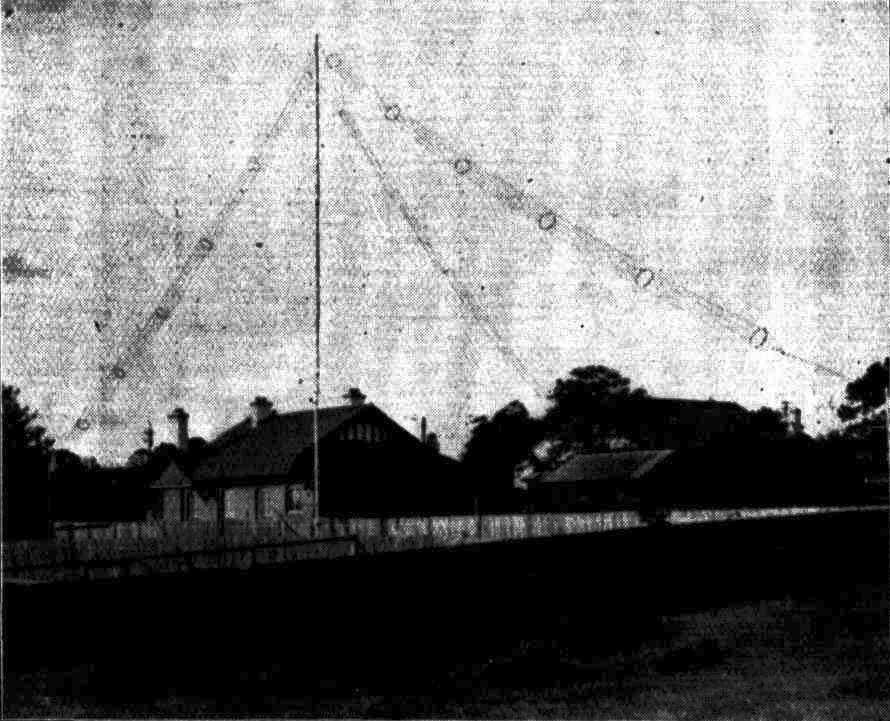
.jpg?timestamp=1384607487687)
 Right: Radio mast and Sir Ernest Fisk's home, Wahroonga (some sources state his home was at Roseville), Creator Hood, Sam, 1872-1953, Image No: hood_7681r, courtesy State Library of NSW. Date of Work after 1917 [probably Sept 1918] Home and Away - 7681 "At 3.15am GMT on the 22nd September 1918 the first direct wireless message was transmitted from the United Kingdom to Australia. The message sent for the Australian Prime Minister, Billy Hughes, whilst visiting his birthplace in Wales, was transmitted by Guglielmo Marconi from Carnarvon and received by Ernest Fisk at Wahroonga, 20 kilometres north of Sydney." (Wahroonga Amateur Historical Radio Association) [The Union Flag flies from the top of the mast and the Australian Flag, in the picture, from the arm? They are drawn in or highlighted]
Right: Radio mast and Sir Ernest Fisk's home, Wahroonga (some sources state his home was at Roseville), Creator Hood, Sam, 1872-1953, Image No: hood_7681r, courtesy State Library of NSW. Date of Work after 1917 [probably Sept 1918] Home and Away - 7681 "At 3.15am GMT on the 22nd September 1918 the first direct wireless message was transmitted from the United Kingdom to Australia. The message sent for the Australian Prime Minister, Billy Hughes, whilst visiting his birthplace in Wales, was transmitted by Guglielmo Marconi from Carnarvon and received by Ernest Fisk at Wahroonga, 20 kilometres north of Sydney." (Wahroonga Amateur Historical Radio Association) [The Union Flag flies from the top of the mast and the Australian Flag, in the picture, from the arm? They are drawn in or highlighted]